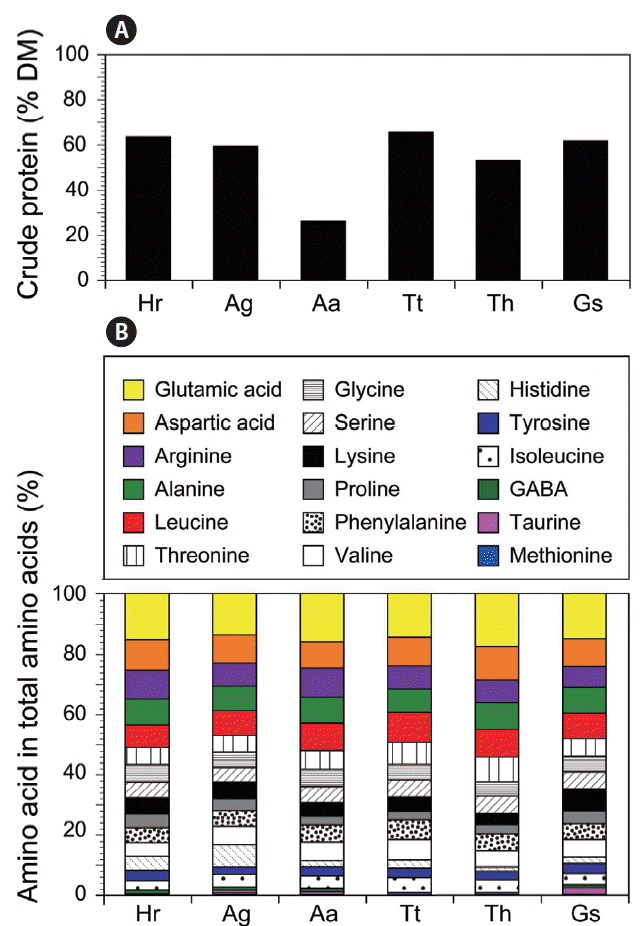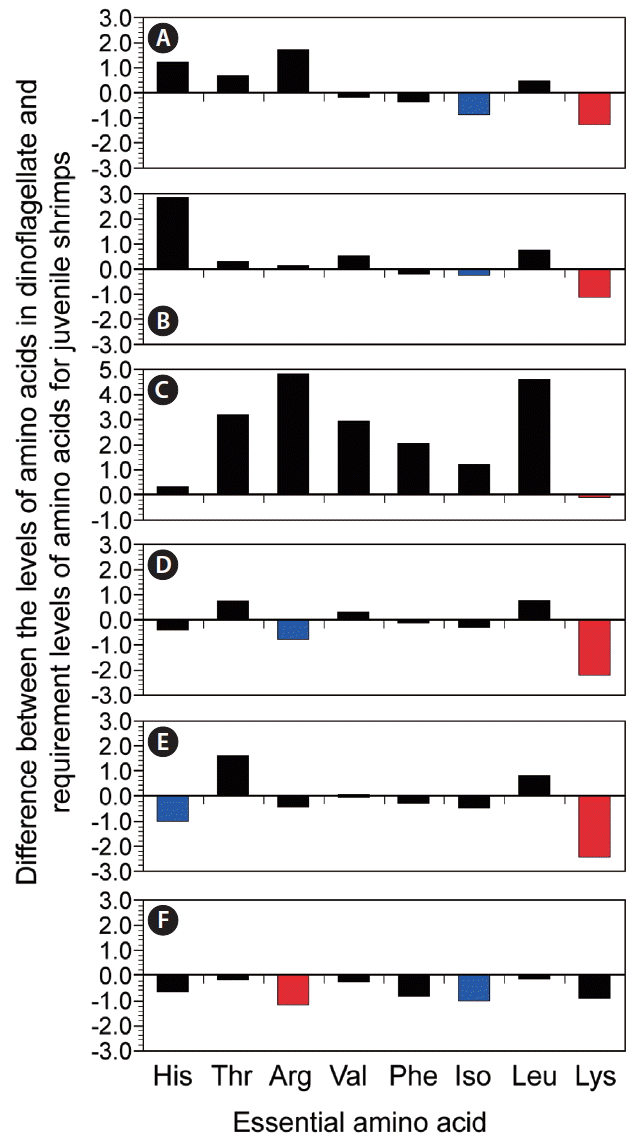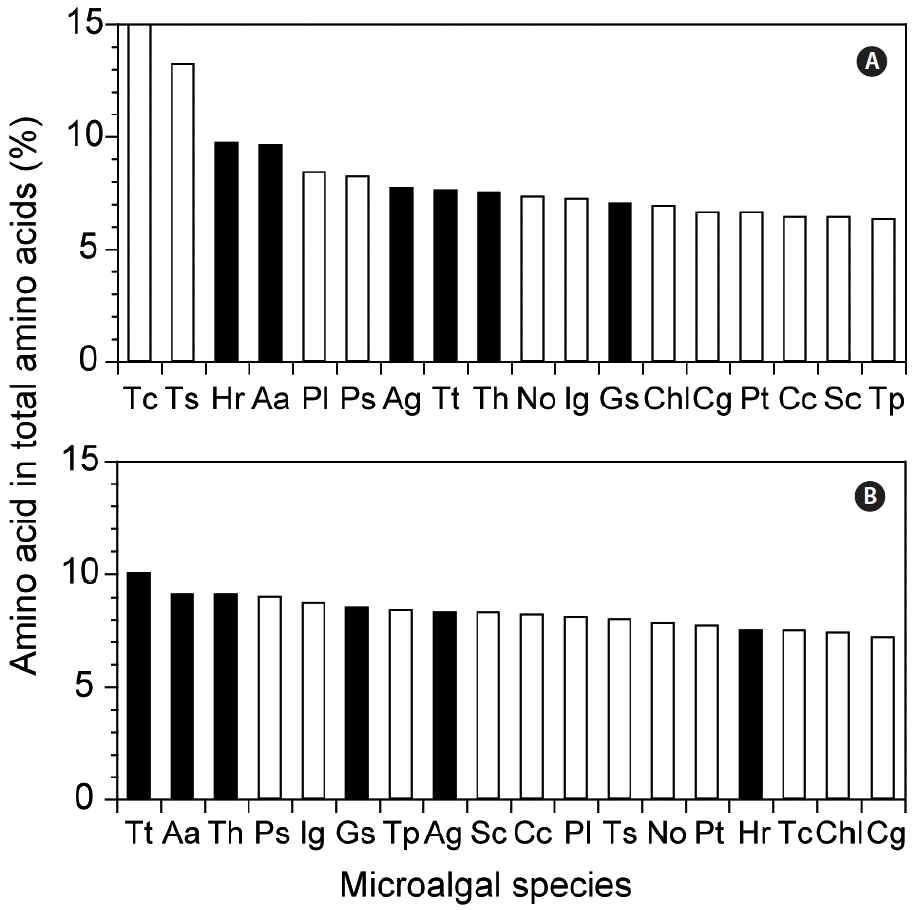Akiyama, DM 1992. Future considerations for shrimp nutrition and the aquaculture feed industry. In : Wyban J, editor Proc Special Session on Shrimp Farming. World Aquaculture Society, Baton Rouge, LA, 198–205.
Andersen, R 2013. The microalgal cell. In : Richmond A, Hu Q, editors Handbook of Microalgal Cultures: Applied Phycology and Biotechnology. 2nd ed. Wiley Blackwell, West Sussex, 3–20.
Becker, W 2004. Microalgae in human and animal nutrition. In : Richimond A, editor Handbook of Microalgal Culture: Biotechnology and Applied Phycology. Blackwell Publishing Ltd, Oxford, 312–351.
Bleakley, S & Hayes, M 2017. Algal proteins: extraction, application, and challenges concerning production. Foods. 6:33 pp.


Borowitzka, MA 1997. Microalgae for aquaculture: opportunities and constraints. J Appl Phycol. 9:393 pp.

Brown, MR 1991. The amino-acid and sugar composition of 16 species of microalgae used in mariculture. J Exp Mar Biol Ecol. 145:79–99.

Brown, MR 2002. Nutritional value and use of microalgae in aquaculture. In : Cruz-Suárez LE, Ricque-Marie D, Tapia-Salazar M, Gaxiola-Cortés MG, Simoes N, editors Advances en Nutrición Acuícola VI.. Memorias del VI Simposium Internacional de Nutrición Acuícola, Universidad Autónoma de Nuevo León, Monterrey, 281–292.
Brown, MR & Jeffrey, SW 1992. Biochemical composition of microalgae from the green algal classes Chlorophyceae and Prasinophyceae. 1. Amino acids, sugars and pigments. J Exp Mar Biol Ecol. 161:91–113.

Buono, S, Langellotti, AL, Martello, A, Rinna, F & Fogliano, V 2014. Functional ingredients from microalgae. Food Funct. 5:1669–1685.


de Salas, MF, Bolch, CJS, Botes, L, Nash, G, Wright, SW & Hallegraeff, GM 2003.
Takayama gen. nov. (Gymnodiniales, Dinophyceae), a new genus of unarmored dinoflagellates with sigmoid apical grooves, including the description of two new species. J Phycol. 39:1233–1246.

Fabregas, J & Herrero, C 1985. Marine microalgae as a potential source of single cell protein (SCP). Appl Microbiol Biotechnol. 23:110–113.

Flynn, KJ & Flynn, K 1992. Non-protein free amines in microalgae: consequences for the measurement of intracellular amino acids and of the glutamine/glutamate ratio. Mar Ecol Prog Ser. 89:73–79.

Gouveia, L, Batista, AP, Sousa, I, Raymundo, A & Bandarra, NM 2008. Microalgae in novel food products. In : Papadopoulos KN, editor Food Chemistry Research Developments. Nova Science Publishers, New York, 75–112.
Guillard, RRL & Ryther, JH 1962. Studies of marine planktonic diatoms: I.
Cyclotella nana Hustedt, and
Detonula confervacea (Cleve) Gran. Can J Microbiol. 8:229–239.


Guiry, MD & Guiry, GM 2018. AlgaeBase, World-wide electronic publication, National University of Ireland, Galway, Available from:
http://www.algaebase.org
. Accessed Sep 10, 2018
Harel, M & Clayton, D 2004. Feed formulation for terrestrial and aquatic animals. U.S. Patent No. 20070082008 (WO/2004/080196). U.S. Patent and Trademark Office, Washington, DC.
Hayashi, T, Suitani, Y, Murakami, M, Yamaguchi, K, Konosu, S & Noda, H 1986. Protein and amino acid compositions of five species of marine phytoplankton. Bull Jpn Soc Sci Fish. 52:337–343.

Hemaiswarya, S, Raja, R, Kumar, RR, Ganesan, V & Anbazhagan, C 2011. Microalgae: a sustainable feed source for aquaculture. World J Microbiol Biotechnol. 27:1737–1746.

Holmes, MJ, Brust, A & Lewis, RJ 2014. Dinoflagellate toxins: an overview. In : Botana LM, editor
Seafood and Freshwater Toxins: Pharmacology, Physiology, and Detection. 3rd. 1:CRC Press, Boca Raton, FL, 3–38.

Jang, SH, Jeong, HJ & Kwon, JE 2017. High contents of eicosapentaenoic acid and docosahexaenoic acid in the mixotrophic dinoflagellate
Paragymnodinium shiwhaense and identification of putative omega-3 biosynthetic genes. Algal Res. 25:525–537.

Jeong, HJ, Jang, SH, Moestrup, Ø, Kang, NS, Lee, SY, Potvin, E & Noh, JH 2014.
Ansanella granifera gen. et sp. nov. (Dinophyceae), a new dinoflagellate from the coastal waters of Korea. Algae. 29:75–99.

Jeong, HJ, Lim, AS, Franks, PJS, Lee, KH, Kim, JH, Kang, NS, Lee, MJ, Jang, SH, Lee, SY, Yoon, EY, Park, JY, Yoo, YD, Seong, KA, Kwon, JE & Jang, TY 2015. A hierarchy of conceptual models of red-tide generation: nutrition, behavior, and biological interactions. Harmful Algae. 47:97–115.

Jeong, HJ, Ok, JH, Lim, AS, Kwon, JE, Kim, SJ & Lee, SY 2016. Mixotrophy in the phototrophic dinoflagellate
Takayama helix (family Kareniaceae): predator of diverse toxic and harmful dinoflagellates. Harmful Algae. 60:92–106.


Jeong, HJ, Yoo, YD, Kim, JS, Seong, KA, Kang, NS & Kim, TH 2010. Growth, feeding, and ecological roles of the mixotrophic and heterotrophic dinoflagellates in marine planktonic food webs. Ocean Sci J. 45:65–91.

Kang, NS, Jeong, HJ, Moestrup, Ø, Lee, SY, Lim, AS, Jang, TY, Lee, KH, Lee, MJ, Jang, SH, Potvin, É, Lee, SK & Noh, JH 2014.
Gymnodinium smaydae n. sp., a new planktonic phototrophic dinoflagellate from the coastal waters of western Korea: morphology and molecular characterization. J Eukaryot Microbiol. 61:182–203.


Kim, JH, Jeong, HJ, Lim, AS, Kwon, JE, Lee, KH, Park, KH & Kim, HS 2017. Removal of two pathogenic scuticociliates
Miamiensis avidus and
Miamiensis sp. using cells or culture filtrates of the dinoflagellate
Alexandrium andersonii
. Harmful Algae. 63:133–145.


LaJeunesse, TC, Parkinson, JE, Gabrielson, PW, Jeong, HJ, Reimer, JD, Voolstra, CR & Santos, SR 2018. Systematic revision of Symbiodiniaceae highlights the antiquity and diversity of coral endosymbionts. Curr Biol. 28:2570–2580.


Lee, KH, Jeong, HJ, Jang, TY, Lim, AS, Kang, NS, Kim, J-H, Kim, KY, Park, K-T & Lee, K 2014a. Feeding by the newly described mixotrophic dinoflagellate
Gymnodinium smaydae: feeding mechanism, prey species, and effect of prey concentration. J Exp Mar Biol Ecol. 459:114–125.

Lee, KH, Jeong, HJ, Kwon, JE, Kang, HC, Kim, JH, Jang, SH, Park, JY, Yoon, EY & Kim, JS 2016. Mixotrophic ability of the phototrophic dinoflagellates
Alexandrium andersonii,
A. affine, and
A. fraterculus
. Harmful Algae. 59:67–81.


Lee, SK, Jeong, HJ, Jang, SH, Lee, KH, Kang, NS, Lee, MJ & Potvin, É 2014b. Mixotrophy in the newly described dinoflagellate
Ansanella granifera: feeding mechanism, prey species, and effect of prey concentration. Algae. 29:137–152.

Lim, AS, Jeong, HJ, Kim, JH & Lee, SY 2015. Description of the new phototrophic dinoflagellate
Alexandrium pohangense sp. nov. from Korean coastal waters. Harmful Algae. 46:49–61.

Lim, AS, Jeong, HJ, Ok, JH & Kim, SJ 2018. Feeding by the harmful phototrophic dinoflagellate
Takayama tasmanica (Family Kareniaceae). Harmful Algae. 74:19–29.


Lourenço, SO, Barbarino, E, Lavín, PL, Marquez, UML & Aidar, E 2004. Distribution of intracellular nitrogen in marine microalgae: calculation of new nitrogen-to-protein conversion factors. Eur J Phycol. 39:17–32.

Madrigal, RFDAG, da Silva, UDAT, Tavares, CPDS & Ballester, ELC 2017. Use of native and non-native shrimp (Penaeidae, Dendrobranchiata) in world shrimp farming. Rev Aquac.
https://doi.org/10.1111/raq.12206
Markell, DA & Trench, RK 1993. Macromolecules exuded by symbiotic dinoflagellates in culture: amino acid and sugar composition. J Phycol. 29:64–68.

Matos, J, Cardoso, C, Bandarra, NM & Afonso, C 2017. Micoalgae as healthy ingredients for functional food: a review. Food Funct. 8:2672–2685.


Menden-Deuer, S & Lessard, EJ 2000. Carbon to volume relationships for dinoflagellates, diatoms, and other protist plankton. Limnol Oceanogr. 45:569–579.

Mendes, A, Reis, A, Vasconcelos, R, Guerra, P & da Silva, TL 2009.
Crypthecodinium cohnii with emphasis on DHA production: a review. J Appl Phycol. 21:199–214.

Millamena, OM, Bautista, MN, Reyes, OS & Kanazawa, A 1997. Threonine requirement of juvenile marine shrimp
Penaeus monodon
. Aquaculture. 151:9–14.

Millamena, OM, Bautista-Teruel, MN & Kanazawa, A 1996. Methionine requirement of juvenile tiger shrimp
Penaeus monodon Fabricius. Aquaculture. 143:403–410.

Millamena, OM, Bautista-Teruel, MN, Reyes, OS & Kanazawa, A 1998. Requirements of juvenile marine shrimp,
Penaeus monodon (Fabricius) for lysine and arginine. Aquaculture. 164:95–104.

Millamena, OM, Teruel, MB, Kanazawa, A & Teshima, S 1999. Quantitative dietary requirements of postlarval tiger shrimp,
Penaeus monodon, for histidine, isoleucine, leucine, phenylalanine and tryptophan. Aquaculture. 179:169–179.

Muller-Feuga, A 2013. Microalgae for aquaculture: the current global situation and future trends. In : Richmond A, Hu Q, editors Handbook of Microalgal Cultures: Applied Phycology and Biotechnology. 2nd ed. Wiley Blackwell, West Sussex, 615–627.
National Research Council 2011. Nutrient requirements of fish and shrimp. National Academies Press, Washington, DC, 376 pp.
Norton, TA, Melkonian, M & Andersen, RA 1996. Algal biodiversity. Phycologia. 35:308–326.

Okaichi, T 1974. Significance of amino acid composition of phytoplankton and suspensoid in marine biological production. Bull Jpn Soc Sci Fish. 40:471–478.

Onodera, K, Konishi, Y, Taguchi, T, Kiyoto, S & Tominaga, A 2014. Peridinin from the marine symbiotic dinoflagellate,
Symbiodinium sp., regulates eosinophilia in mice. Mar Drugs. 12:1773–1787.



Oser, BL 1959. An integrated essential amino acid index for predicting the biological value of proteins. In : Albanese AA, editor Amino Acid Nutrition. Academic Press, New York, 295–311.
Pulz, O & Gross, W 2004. Valuable products from biotechnology of microalgae. Appl Microbiol Biotechnol. 65:635–648.


Roy, SS & Pal, R 2015. Microalgae in aquaculture: a review with special references to nutritional value and fish dietetics. Proc Zool Soc. 68:1–8.

Sánchez, RM 1986. Rearing of misid stages of
Penaeus vannamei fed cultured algae of three species. Aquaculture. 58:139–144.

Shah, MR, Samarakoon, KW, An, S-J, Jeon, Y-J & Lee, J-B 2016. Growth characteristics of three benthic dinoflagellates in mass culture and their antioxidant properties. J Fish Aquat Sci. 11:268–277.

Shimizu, Y 1996. Microalgal metabolites: a new perspective. Annu Rev Microbiol. 50:431–465.


Singh, J & Gu, S 2010. Commercialization potential of microalgae for biofuels production. Renew Sustain Energ Rev. 14:2596–2610.

Singh, J & Saxena, RC 2015. An introduction to microalgae: diversity and significance. In : Kim S-K, editor Handbook of Marine Microalgae: Biotechnology Advances. Academic Press, San Diego, CA, 11–24.
Spolaore, P, Joannis-Cassan, C, Duran, E & Isambert, A 2006. Commercial applications of microalgae. J Biosci Bioeng. 101:87–96.


Taylor, FJR, Hoppenrath, M & Saldarriaga, JF 2008. Dinoflagellate diversity and distribution. Biodivers Conserv. 17:407–418.

Teshima, S, Alam, MS, Koshio, S, Ishikawa, M & Kanazawa, A 2002. Assessment of requirement values for essential amino acids in the prawn,
Marsupenaeus japonicus (Bate). Aquac Res. 33:395–402.

Zhang, T, Chi, Z & Sheng, J 2009. A highly thermosensitive and permeable mutant of the marine yeast
Cryptococcus aureus G7a potentially useful for single-cell protein production and its nutritive components. Mar Biotechnol. 11:280–286.








